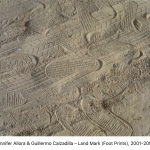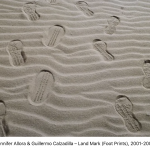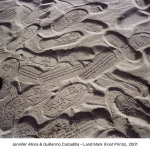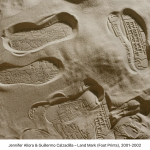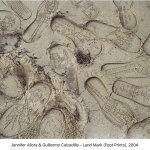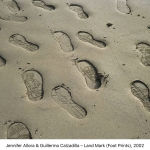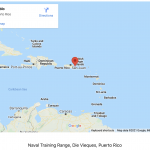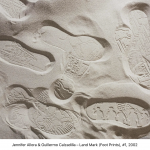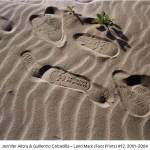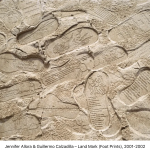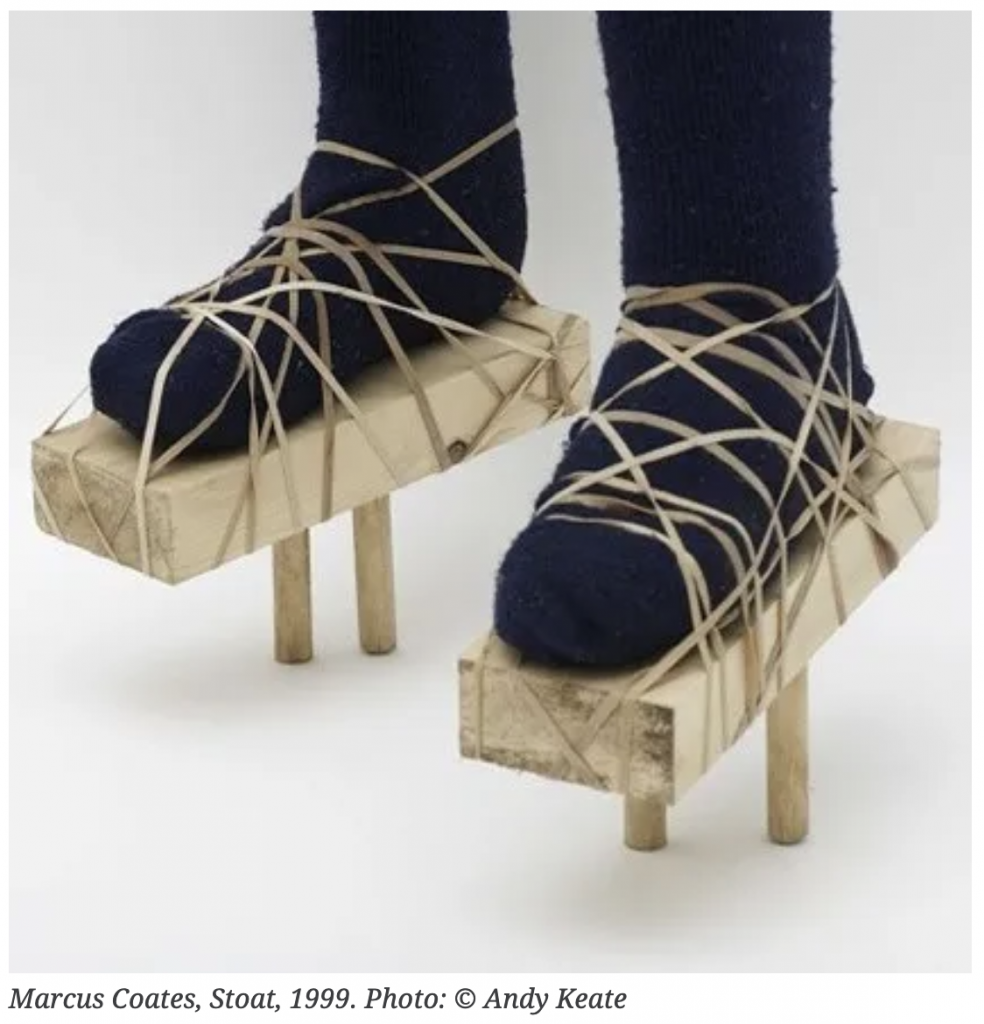“Paradox of Praxis 1 (1997) is the record of an action carried out under the rubric of “sometimes making something leads to nothing.” For more than nine hours, Alÿs pushed a block of ice through the streets of Mexico City until it completely melted. And so for hour after hour he struggled with the quintessentially Minimal rectangular block until finally it was reduced to no more than an ice cube suitable for a whisky on the rocks, so small that he could casually kick it along the street.”
Category Archives: Wearables and Tools
Nevin Aladag, Session (2013)
“Session is a video triptych shot in Sharjah’s urban areas and desert. In this musical composition, different kinds of Arabic, African and Indian percussion instruments, all found in the United Arab Emirates, are played by the elements – the sand, the sea and the wind.”
From Wanderlust catalog: “Aladag’s work explores the textures of socio-spatial environments and global cultural identity. In Sessions we are thus invited to become not only viewers and listeners, but also voyagers and cartographers, navigating the enigmatic edges of our surrounding environments through surfaces and socially activated gestures.”
Michelangelo Pistoletto, Walking Sculpture (1967)

Michelangelo Pistoletto, Walking Sculpture (1967)
Pistoletto (1933-) rolls a ball made of newspaper down the streets, beckoning the participation of the whole community. This work is considered part of the Art Povera movement.
Efrat Natan, Head Sculpture (1973)
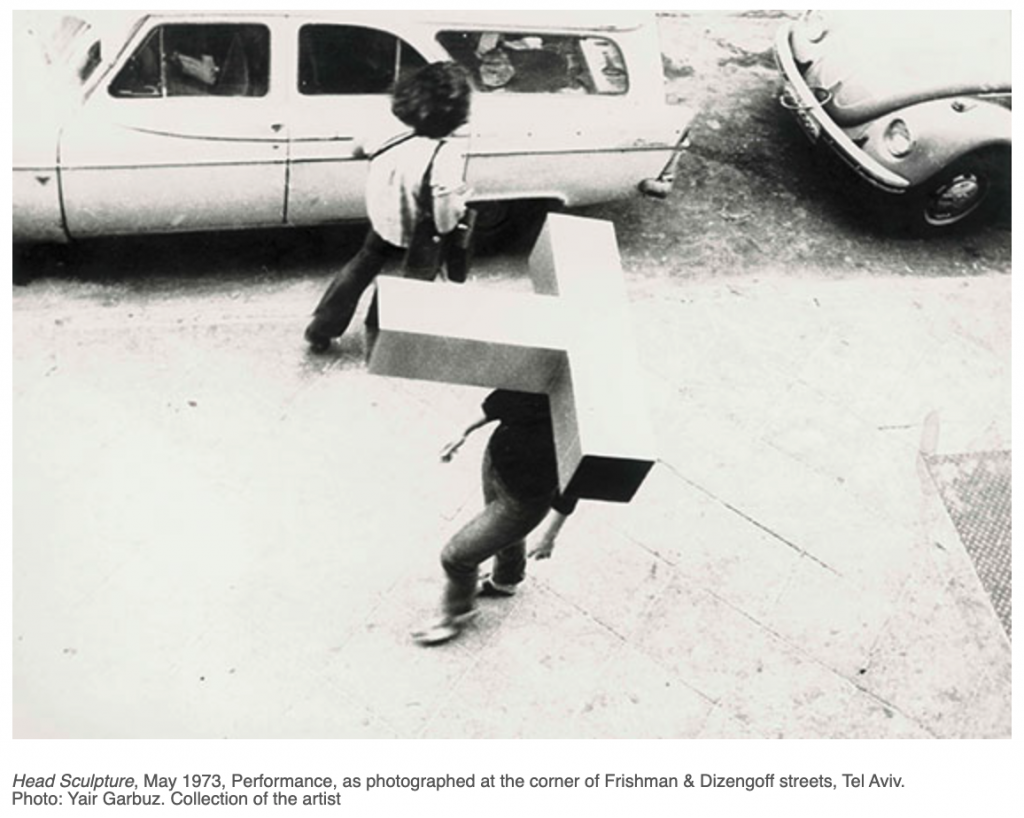
Efrat Natan, Head Sculpture
Head Sculpture (1973) by Efrat Natan (1947-) has photo documentation that presents a descriptive view of what occurred during the walking performance, and what it looked like from multiple angles. In this work, Natan used a wearable T-shaped sculpture that narrowed the field of view and hearing for the wearer, emphasizing concepts of surveillance and mapping. The photographs showcase both the sculpture and the figure in the street.
“Natan walked through the streets of Tel Aviv, her head covered by a hollow plywood, T-shaped box/mask/sculpture the morning after [the independence day] military parade [in Jerusalem, five months before the outbreak of the Fourth Arab-Israeli War], meld[ing] the language of minimalism, body art and installation art of that period with Christian influences (public self-signifying is a mark of Cain; the act is one of walking the Via Dolorosa).” [credit] The sculpture “can be read as a cross, as an airplane, and even as an angel with outspread wings.” [credit]
“The Minimalism went well with my shyness: it was a kind of mask. The space, which sits strongly in my body, led me to Body Art”, Natan says. Body Art sets up the artist’s body as a central object to be viewed, and puts the tension between the body as subject and as object in the center of the action.” [credit]
“The T-shape is reminiscent of the children’s house in her kibbutz. The sculpture’s visual appearance calls to mind Robert Morris or Charlotte Posenenske. Due to her restricted field of vision, Natan could only see part of the people surrounding her.” [credit] ”
“The kibbutz, where she had lived from her second year of elementary school until the end of her 11th-grade year in high school. The T-shaped structure of the children’s house, the most familiar architectural structure of her life in the kibbutz, contained bedrooms, a dining room, the showers, and a classroom. The long side of the children’s house, with the dining room in the center and the bedrooms on both its sides, faced west.” [credit]
“Head Sculpture (1973) was Efrat Natan’s first street performance to a chance audience. In many ways, this work was a harbinger of an artistic genre of quiet action in the public space, which was recognized thanks to the remaining photographic images. Such works, that combine body art and minimalist sculpture, are formed in a space that is devoid of institutional artistic context, with the very occurrence often affecting the content of the work. Thus, for example, the title of this work was given by two random tourists who were observing Natan walking along Dizengoff and Frishman Streets, her head stuck in a hollow MDF sculpture in the shape of a cross, or the letter X or a plus sign. One tourist said to the other: “Look! A head sculpture!”” [credit]
From the Wanderlust catalog: “Natan draws on her upbringing in her work, which reflects the Israel “religion of labor” and the ideological imperative of “making do with little.”
“The flattened aerial perspective transforms the human form into a sculptural object and suggests modes of surveillance and mapping, which are emphasized by the function of the sculpture itself”
“Her performance suggests a framing and reduction of the senses and the ambiguity inherent in collecting a narrow field of vision and hearing.”
Allan Kaprow, Taking a Shoe for a Walk (1989)

From Wanderlust catalog, Kaprow states “Any avant-garde art is primarily a philosophical quest and a finding of truths, rather than purely an aesthetic activity.”
Score for Taking a Shoe for a Walk (1989)
pulling a shoe on a string through the city
examining the shoe from time to time, to see if it’s worn out
wrapping your own shoe, after each examination, with layers of bandage or tape, in the amount you think the shoe on the string is worn out
repeating, adding to your shoe more layers of bandage or tape, until, at the end of the walk, the shoe you are pulling appears completely worn out
Jennifer Allora & Guillermo Calzadilla “Land Mark (Foot Prints)” (2001-2002)
The Land Mark series was a civil disobedience campaign. Over 2001 and 2002, Allora and Calzadilla, together with a group of activists, encroached into one of the United States Navy Bombing range in a beach of Vieques, Puerto Rico. The U.S. Military and NATO have used this location for various military exercises for more than 60 years.
The two artists collaborated with the resistance group to produce rubber shoes that came with distinct soles. The customized shoe soles were engraved with different messages and images that silently yet strappingly put forward the grievances, opinions, and demands of the protestors.
Even though the activists entered the realms of the bombing range illegally, their objective was to bring about their messages under the attention of the military staff employed in that particular military facility. Some of these memoranda were explicit, while the others subtly hinted at their claims. The primary objective, however, was to reclaim the disputed territory, thereby rendering the term landmark with a whole new meaning.
Land Mark discusses the discrimination and forceful acquiring of Vieques by the U.S. Navy, which was initiated during the Second World War and ended only in 2003. The military practiced bombing and secretly tested various technologies, including the hazardous napalm and radioactive shells on the island’s residents during 1969.
Conor McGarrigle, “WalkSpace: Beirut-Venice” (2012)
As part of THESTATEOFMIND for the Lebanese Pavilion at the Venice Biennale of Art 2011. WalkSpace: Beirut-Venice invites the participant on a drift through Venice guided from Beirut and in Beirut guided from Venice.
The work involves two simultaneous dérives (drifts) through the historic cities of Beirut and Venice, connected in real time to each other and to the world. Two interconnected groups of participants will walk in each city, each receiving instruction and guidance from the other as they wander, get lost and explore the psychogeographical ambience of the city.
The progress of each group will be broadcast as a live video stream via Bambuser, tracked in realtime on a map with Google latitude and tweeted with followers having the option of giving instructions via twitter.
The object is not to create a finite discrete work but to create a peripatetic relational space which can evolve and respond to the situation, the desires of its participants and serendipity, with the work being created through the actions of its participants. The space is furthermore overlaid with a hybrid, networked space connecting both cities and augmenting each space with the absent presence of the other.
Working from a changing set of basic instructions such as ‘describe what you see’, ‘follow that person’, ‘take the next left and then the first right’ or the more loaded ‘take me to the heart of the city’ the two groups will walk in tandem each guiding the other, walking in Beirut as if in Venice and Venice as if in Beirut.
The project draws on early dérives carried out by the Situationists in Amsterdam and Strasbourg which connected groups in different parts of the cities with walkie talkies and Ralph Rumney’s 1957 Psychogeographical Map of Venice.
Participate
We invite the audience to follow us in real time using Bambuser for video, Google latitude for locations and with geotagged tweets. We invited those not in Venice or Beirut to follow us virtually with the following services.
Latitude: We will be broadcasting out location in real time during the event using Google Latitude. To track the event first sign up for Latitude and send a request to share location to allegora.venice[AT]gmail.com, or alternatively email allegora.venice[AT]gmail.com and we will share our location with you. You do not need to share your location to follow us.
Bambuser: To view our live video feed simply visit bambuser.com/channel/stateofmind
Marcus Coates, “Stoat” (1999)
[credit]
Single Channel Digital Video
Duration: 3 min
Filmed in Grizedale, Cumbria, UK
Camera and sound: Miranda Whall
, Produced by Grizedale Arts
Here Coates attempts to become Stoat, a member of the weasel family. We see him stumbling along a rural stoney track, wearing home made ‘stoat stilts’. A section of 2×4 inch wood strapped to each of his feet with multiple elastic bands are the basis for each shoe, below this though are the two sections of small circular dowling protruding from each which Coates is intent on balancing on. Eventualy, after some ankle turning falls manages to find a way of striding sideways in them. The stilts, replicating the stoat’s paw print dimensions and spacing, create a physical limitation on his body which inadvertently makes his walk not dissimilar to that of a bounding stoat. The stitls are an unconscious mechanism for him to “become’ stoat and move from humanness
Mona Hatoum, Performance Still [from Roadworks exhibition] (1985-95)
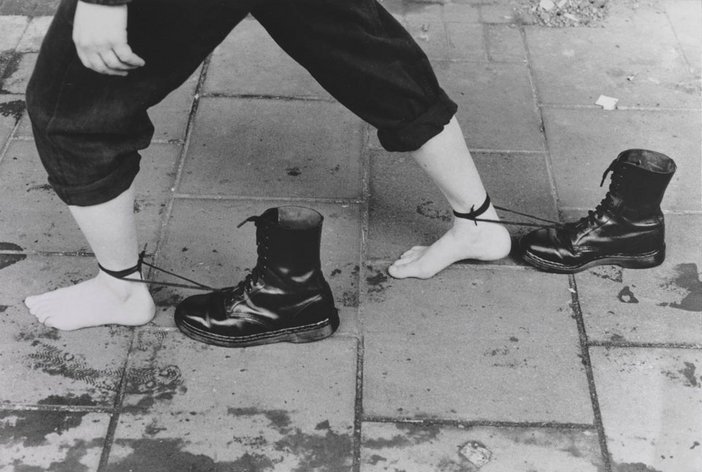
Mona Hatoum, Performance Still (1985–95)
Performance Still 1985 records one of three street performances which Hatoum carried out in Brixton for the Roadworks exhibition organised in 1985 by the Brixton Artists Collective. The performance consisted of the artist walking barefoot through the streets of Brixton for nearly an hour, with Doc Marten boots, usually worn by both police and skinheads, attached to her ankles by their laces. Performance Still, printed and published ten years later turns the original documentary photograph of the performance into a work in its own right, and has therefore come to identify this aspect of Hatoum’s practice.
Gallery label, October 2013
Krzysztof Wodiczko, “Alien Staff” (1993-94)
In the Alien Staff project, alien means a state of being and ‘becoming’ both political and metaphysical, nomadic and migrant – a sort of psychological encampment in the space and time of today’s displaced and estranged world.
No aliens, residents, non-residents, legal and illegal immigrants have voting rights, nor any sufficient voice nor image of their own in official “public space”. When given a chance by the media (mainstream or ethnic) to communicate their experience or to state their opinions, demands and needs, immigrants find themselves framed and silenced.
The Alien Staff is a form of portable public address equipment and cultural network for individuals and groups of immigrants. It is an instrument that gives the individual immigrant a chance to “address” directly anyone in the city who may be attracted by the symbolic form of the equipment and the character of the “broadcasted” program.
The Alien Staff resembles the biblical shepherd’s rod. It is equipped with a high-tech mini-monitor and a small loud-speaker. The central part of the rod, the ‘Xenolog section’ is made up of interchangeable cylindrical containers for the preservation and display of precious relics related to the various phases of the owners history. A small image on the screen may attract attention and provoke observers to come very close to the monitor and therefore to the operator’s face, the usual distance from the immigrant, the stranger, decreases.
Upon closer examination, it will become clear that the image on the screen and the actual face of the person are of the same immigrant. The double presence in ‘media’ and in ‘life’ invites a new perception of the stranger as ‘imagined’ (a character on the screen) or as ‘experienced’ (an actor off-stage – a real life person). Since both the imagination and the experience of the viewer are increasing with the decreasing distance, while the program itself reveals unexpected aspects of the actor’s experience, the presence of the immigrant becomes both legitimate and real. This change in distance and perception might provide the ground for greater respect and self-respect, and become an inspiration for crossing the boundary between a stranger and a non-stranger.
As the identities of these persons are not only unstable but also often in antagonistic relation to each other, the only common ground they share is their resistance against any imposed (even self-imposed) uniform or generalised notion of a so-called immigrant identity.
The first model of the Alien Staff was built and tested in Barcelona in June 1993, following the first comprehensive exhibition of Wodiczko’s work in Europe in 1992, entitled Instruments, Projections, Vehicles, at the Fondació Antoni Tapies, Barcelona. A second model was built and its design further transformed in Brooklyn during the summer, fall and the winter 1992-93. The Alien Staff was used by many immigrants in New York, Paris, Houston, Marseille, Stockholm, Helsinki, Warsaw.
In Rotterdam, before and during Next 5 Minutes (1996), local operators walked through the city with Krzysztof Wodiczko projects Alien Staff and Mouth Piece. Aided by electronic walking sticks and mouth-size monitors they demonstrated how to communicate in an unfamiliar cultural environment and language.
